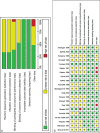Nonsteroidal Anti-inflammatory Drugs as Prophylaxis for Heterotopic Ossification after Total Hip Arthroplasty: A Systematic Review and Meta-Analysis
- PMID: 25950691
- PMCID: PMC4602535
- DOI: 10.1097/MD.0000000000000828
Nonsteroidal Anti-inflammatory Drugs as Prophylaxis for Heterotopic Ossification after Total Hip Arthroplasty: A Systematic Review and Meta-Analysis
Abstract
Heterotopic ossification (HO) is a frequent complication after total hip arthroplasty (THA). Nonsteroidal anti-inflammatory drugs (NSAIDs) have been used as routine prophylaxis for HO after THA. However, the efficacy of NSAIDs on HO, particularly selective NSAIDs versus nonselective NSAIDs, is uncertain.We searched PubMed, Embase, the Cochrane Central Register of Controlled Trials, and clinicaltrials.gov to identify randomized controlled trials with respect to HO after THA. Two reviewers extracted the data and estimated the risk of bias. For the ordered data, we followed the Bayesian framework to calculate the odds ratio (OR) with a 95% credible interval (CrI). For the dichotomous data, the OR and 95% confidence interval (CI) were calculated using Stata version 12.0. The subgroup analyses and the Grading of Recommendations, Assessment, Development and Evaluation (GRADE) approach were used.A total of 1856 articles were identified, and 21 studies (5995 patients) were included. In the NSAIDs versus placebo analysis, NSAIDs could decrease the incidence of HO, according to the Brooker scale (OR = 2.786, 95% CrI 1.879-3.993) and Delee scale (OR = 9.987, 95% CrI 5.592-16.17). In the selective NSAIDs versus nonselective NSAIDs analysis, there was no significant difference (OR = 0.7989, 95% CrI 0.5506-1.125) in the prevention of HO. NSAIDs could increase discontinuation caused by gastrointestinal side effects (DGSE) (OR = 1.28, 95% CI 1.00-1.63, P = 0.046) more than a placebo. Selective NSAIDs could decrease DGSE (OR = 0.48, 95% CI 0.24-0.97, P = 0.042) compared with the nonselective NSAIDs. There was no significant difference with respect to discontinuation caused by non-gastrointestinal side effects (DNGSE) in NSAIDs versus a placebo (OR = 1.16, 95% CI 0.88-1.53, P = 0.297) and in selective NSAIDs versus nonselective NSAIDs (OR = 0.83, 95% CI 0.50-1.37, P = 0.462).NSAIDs might reduce the incidence of HO and increase DGSE in the short-term.
Conflict of interest statement
The authors have no funding and conflicts of interest to disclose.
Figures














References
-
- Stauffer RN, Sim FH. Total hip arthroplasty in Paget's disease of the hip. J Bone Joint Surg Am 1976; 58:476–478. - PubMed
-
- Colville J, Raunio P. Charnley low-friction arthroplasties of the hip in rheumatoid arthritis. A study of the complications and results of 378 arthroplasties. J Bone Joint Surg Br 1978; 60-B:498–503. - PubMed
-
- Neal B, Gray H, MacMahon S, et al. Incidence of heterotopic bone formation after major hip surgery. ANZ J Surg 2002; 72:808–821. - PubMed
-
- Garland DE. A clinical perspective on common forms of acquired heterotopic ossification. Clin Orthop Relat Res 1991; 13–29. - PubMed
-
- Harris WH. Traumatic arthritis of the hip after dislocation and acetabular fractures: treatment by mold arthroplasty. An end-result study using a new method of result evaluation. J Bone Joint Surg Am 1969; 51:737–755. - PubMed
Publication types
MeSH terms
Substances
LinkOut - more resources
Full Text Sources
Medical

